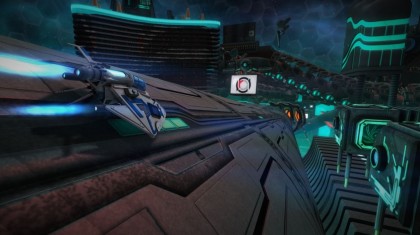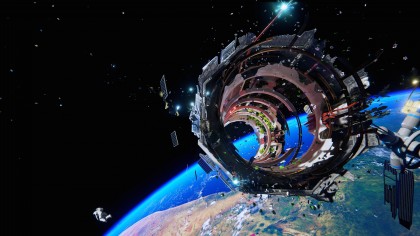These Oculus Rift launch games would immediately justify my huge overdraft
Games are Oculus Rift's secret weapon

My head is spinning. I'm fresh from an Oculus event at GDC 2016, where I played – yes, played – nearly half a dozen launch titles for the Rift headset.
The quality of the games is superb. These were more than just mere 'demos' or 'experiences' – these were fully-fledged worlds where I could shoot, race, play and even die.
Oculus took a back seat at the event, though founder Palmer Luckey and head of content Jason Rubin were roaming the floor, ready to answer any and all questions.
Still, this event was about the developers, the creators that are going to help Oculus Rift sink or swim. And based on what I saw, I think it's going to swim just fine.
Let's get the hardware out of the way. I was using the final consumer Oculus Rift, and it's the lightest and sleekest headset I've worn yet.
Oculus staffers helped me strap it onto my head at every stop, so we'll see how it transitions into people's living rooms as they adjust it the first few times themselves. But with the headset situated properly (wearing my glasses the whole time), I felt like I could wear the Rift for hours – with a few breaks – without fatigue.
The games were running on Oculus-certified machines, and most I was told were optimized to use Oculus Rift. Running at 90fps, it was the optimal set-up to play VR games on, and if you decide to get a Rift when it launches later this month, I suggest you follow the recommended specs, based on what I experienced.
Sign up for breaking news, reviews, opinion, top tech deals, and more.
All but one game I played used an Xbox One controller, and the controls were generally the same between them.
Oculus Rift games
The games I played in small private demo rooms off Market Street in San Francisco were a potpourri, a taste of the 30 titles Oculus Rift will have ready at launch. In all, 41 games were shown over the course of several days at GDC. Most I tried will be available when Rift launches on March 28, and I've indicated their release dates along with prices below.
It's important to note that Oculus has refined its game comfort level scale: titles are now rated as Comfortable, Moderate or Intense. An intense game isn't necessarily uncontrolled mayhem – a roller coaster experience could be labeled Intense. As someone who tends to feel disoriented and can get motion sickness in VR, it was helpful to know what I was walking into ahead of time.

I started off with a game that was firmly in the Comfortable zone: Colopl Titles' Fly to KUMA (March 28, $14.99). In it, I had to help little bears maneuver over bridges by manipulating blocks. It was a cute puzzle game with lovable teddies that, sadly, all too often met their untimely demise thanks to my poor planning.
I later transitioned to a Moderate, mellow VR Tennis Online game (March 28, $24.99) by Colopl that I could easily see myself spending an hour or so playing after work. It was very much a video game in the sense of having bubble-gum colors and unrealistic-looking characters, but it didn't detract from my feeling present in the game. I was really good at it, and I was so invested that I wanted to keep playing even after I lost the match.

Radial G: Racing Revolved (March 28, $24.99) by Tammeka Games was cut from an entirely different cloth. A space racing game with tracks suspended in some sort of galaxy, I basically raced a pod against other competitors (the game will be multiplayer). It was fast-paced, gritty and exhilarating. At one point, with techno music pulsing in my ears and after a particularly good series where I hit a few green boosters in a row, I thought, "How cool is it that this is how I'm spending my Tuesday morning?"
I did begin to feel motion sickness as the vortex of movement pushed my limits: I was moving my head to see more of the VR world and steering my pod around the tube-shaped track as it was rotating. It was trippy in a neat way for a split second before I decided – or, rather, my stomach did – that I needed to cool my jets for a minute.

ADR1FT (March 28, $19.99) was another game where the line to nausea was very thin. I was basically an astronaut stuck on a badly damaged space ship. I had to propel myself with boosters to reach scattered oxygen canisters. The kicker was that boosting caused my oxygen to deplete as it was being used as a fuel source. This, all while the effects of zero gravity were causing me to float upward and bang into the space ship. I had to correct this by descending, thus depleting more oxygen.
There were times when my rising, falling and the movement of floating space junk became too disorienting, but a reset button allowed me to re-center myself when needed. The game was a bit too much for me, but the level of detail and the relentless sense of danger – get to the oxygen tanks before I suffocate – left an impact.
Switching gears entirely, Dragon Front (Spring, F2P) had no movement on my part at all, but it was still completely immersive. I was essentially a giant floating mask with a chessboard-like grid in front of me. I had to draw cards and populate my grid with units or fortifications. All the while, my opponent was drawing cards to build up his forces to either attack or defend against mine.
Producer Keith Hladik of Dragon Front-developer High Voltage told me the team came up with over 130 unique characters for the game. Each specific character type had its own voice and personalized movements.
The rules were too complicated for me to grasp in my 20-minute playtime, but I relished the opportunity to chill out after two Intense games while still experiencing a completely immersive VR world. Imagine Hearthstone with all original characters in virtual reality, and that's what Dragon Front was like.

Next up – and not on my schedule, but what the hell – was Project CARS (March 28, $49.99). I'd heard good things about this racing game, and had to check it out for myself.
It did not disappoint. The actual racing was as good as it could have been, but it was the attention to detail and the realism of the experience that struck me most. I felt like I should reach up to adjust my review mirror, and found myself checking my side mirrors before I went back on the track. I crashed into a barrier at one point, and my windshield was so badly cracked, I had to move my head in the real world to try to get a good angle to see. Instead of being frustrating, it felt completely appropriate.
Game Director Stephen Vilijoen said players can follow the career path of a Formula 1 racer, progressing in their careers just as a competitor on the circuit would, though no level is off limits.

Michelle was previously a news editor at TechRadar, leading consumer tech news and reviews. Michelle is now a Content Strategist at Facebook. A versatile, highly effective content writer and skilled editor with a keen eye for detail, Michelle is a collaborative problem solver and covered everything from smartwatches and microprocessors to VR and self-driving cars.